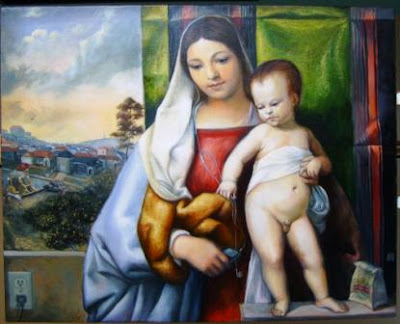Venetian painters at the time of Titian used a different technique from that of
later painters. The modern artist usually paints the forms directly on the canvas
with color mixed in his palette. This is essentially a one‐step method, although
the artist may paint over a preliminary sketch. By contrast, theVenetian painter
from the sixteenth century used a two‐step method. First, he defined the forms
of his composition in monochrome, and only after that was completed he applied
color. When he applied color, he did so in translucent layers called glazes.
To demonstrate the Venetian method of painting for this book, I have illustrated a
step by step of the process. The intention is not to show how exactly someone like
Titian painted this picture (The Gipsy Madonna) but to illustrate the main steps of
work in a simplified demonstration of fundamentals. By emulating this process one
can understand the importance or order, structure, discipline and patience involved
in making a painting. Something that most of the contemporary art world has forgotten.
This is the original Gipsy Madonna painted by Titian in 1510
The following is part of a demo I used in a class on how to paint like the Old Masters .I taught this class at the Maitland Art Center.
Step #1: “Bozzetto” ( Preliminary Sketch)
Prepare a pencil preliminary study of the composition on paper
Prepare a pencil preliminary study of the composition on paper
Step #2: “Disegno” (Drawing)
Transfer and draw the composition on to canvas with vine charcoal.
Transfer and draw the composition on to canvas with vine charcoal.
Step #3: “Sotto Disegno” (Underdrawing)
Draw and re‐define lines with Burnt Umber and Turpentine
(This is called “The Sauce”)
Draw and re‐define lines with Burnt Umber and Turpentine
(This is called “The Sauce”)
Step #4: “Imprimatura “(Toned canvas)
Over the underdrawing, apply a light tone of Venetian Red or Red
Ochre (PR101) with a mixture of linseed oil and turpentine.
Over the underdrawing, apply a light tone of Venetian Red or Red
Ochre (PR101) with a mixture of linseed oil and turpentine.
Step #5: Togliere Strofinare” (Wipe out technique)
Wipe out the strongest lights in the composition. This is done with a dry
fine cotton rag and gently rubbing out the selected areas where the
lights are supposed to be.
Wipe out the strongest lights in the composition. This is done with a dry
fine cotton rag and gently rubbing out the selected areas where the
lights are supposed to be.
Step#6: “Sotto Dipinto” (underpainting)
With black, white and yellow ocher paint and define values with grays
present in the composition.
Step #7 Velaturas (Color Glazing)
Thin color glazes are applied using the “motherload” glazing medium. Semi‐dry
paint scumbling is applied over the dry glaze. Additional elements in the
background are added to the composition. You may apply various layers of glazes.









No comments:
Post a Comment